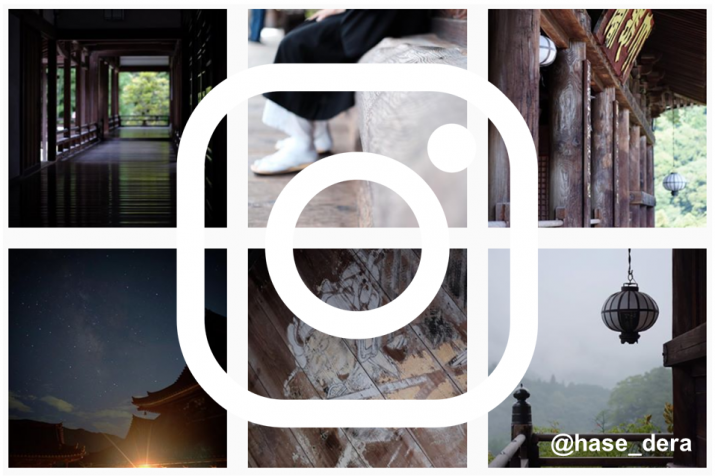NEWS
Buddhist Temples in Japan Join the Instagram Craze
 Screenshot of the @hase_dera instagram account. From instagram.com/hase_dera/
Screenshot of the @hase_dera instagram account. From instagram.com/hase_dera/Japan’s famously photogenic Buddhist temples of have long been advertised by travel agencies as locations that are sure to make your Instagram followers swoon, but amid the declining interest in Buddhism in Japan,* some of these world-famous temples have opted to join Instagram themselves to promote their charms and attract new visitors with their unique Buddhist aesthetic.
In some cases, it is a temple’s remote location that inspired one of the priests to open an Instagram account, on other occasions it is part of a well-designed marketing strategy, but temples across the country are posting images of cherry blossoms, colorful autumn leaves, behind-the-scenes images of monastic life, and even the odd video of a Buddhist service, in an effort to reach out to a new and global audience, and generate renewed interest in the Buddhist faith.
Chionin Temple in Kyoto, the head temple of the Jodo Shu school joined Instagram in April. The images on the account @chion_in are taken by the resident priests and feature scenes of their day-to-day activities, of the people that come visit, and of the occasional tortoise or cat. Some of the younger priests propsed the idea of opening an account to attract more visitors.
“Letting the world know about us is one of the ways for religion to do things in today’s world, instead of just having temples wait for worshippers to come,” explained priest Ryuho Ikeguchi, 37. (The Asahi Shimbun)
Kiyomizudera in Kyoto, one of Japan’s most famous temples and a UNESCO World Heritage Site, joined Instagram in 2014, well before the app became a global phenomenon. The official account @feel_kiyomizudera now has 167,000 followers from all over the world and features more than 400 images taken by the professional photographer Kazuya Sudo, 37. The temple even published a photobook in 2016 and Instagram’s chief product officer visited the temple last year.
Priest Eigen Onishi, 40, hopes that the images will help visitors to embrace the Buddhist practice. “When you visit the temple, we want you to put your hands together in prayer and reflect on yourself,” he commented. “Spending time taking pictures with a smartphone may also be important, but worshippers can save time doing so when we post photos on Instagram. We hope they spend that time for a moment of prayer.” (The Asahi Shimbun)
Buddhist priest Koki Takiguchi, 36, also sought to (re-)connect people with Buddhism, specifically the bodhisattva Kannon, when he opened an Instagram account for the remote Hasedera Temple in Nara, the head temple of the Shingon sect’s Buzan school, in May 2016. Hasadera Temple is located deep in a forest and is, as such, hard to reach. Visitors have dwindled in recent years, but with the help of Instagram, the number of virtual visitors is soaring. According to Takiguchi, who is responsible for taking, editing, and posting the images on the Instagram account, the remoteness provides one advantage: because of its unique location, the scenery around the temple is very picturesque or “Insta-worthy,” and the account @hase_dera features many of the varied foliage and plants in the area.
Hasadera Temple is also part of an Instagram-related campaign launched by Saikoku Sanjusan-sho Fudashokai—an association of 33 temples along the ancient pilgrimage route Saikoku Sanjusan-sho associated with the bodhisattva Kannon. The website of the organization features images of “Insta-worthy” spots on the grounds of each of the 33 temples along the route and invites vistors to find these locations and share their own photos on Instagram.
Instagram is not the only social media that has been co-opted by Japanese Buddhist temples. Last November, officials of the Tendai school of Buddhism, headquartered at Enryaku temple on Mount Hieizan in Otsu, posted a virtual reality video on YouTube featuring Kabuki actor Ichikawa Ennosuke showing the viewer eight noteworthy spots at the temple.
“As emphasis has been laid on the fact that people are distancing themselves from temples, we must also change ourselves or we will dwindle,” explained Kisen Hoshino, chief of the Tendai school’s educational section. “It has become time to use new tools like social networking services and videos to implement online strategies in a proactive manner.” (The Asahi Shimbun)
* There have been recent warnings that Buddhism may be approaching something of a crisis point in Japan, with 27,000 of the country’s 77,000 Buddhist temples forecast to close over the next 25 years, reflecting shrinking populations in small rural communities and a loss of faith in organized religion among the country’s population as a whole. See more: Almost One-Third of Japan’s Buddhist Temples Expected to Close by 2040 (Buddhistdoor Global)
See more
Buddhist temples gain followers with Instagram, SNS accounts (The Asahi Shimbun)
Buddhist priest uses SNS to raise hard-to-reach temple’s profile (The Asahi Shimbun)
Related news from Buddhistdoor Global
Japanese Buddhist Priest Transforms Traditional Goshuin Stamps into Works of Art
MBA Monk Aims to Rejuvenate Japan’s Buddhist Temples
Japanese Priest Serves Up Pure Land Buddhism with Techno Beats
Japan Seeks World Heritage Status for Country’s Oldest Buddhist Pilgrimage Route
Buddhist Monks Extend a Helping Hand to Japanese Singles Seeking Romance
Buddhist Monks Are Only a Click Away in Japan














